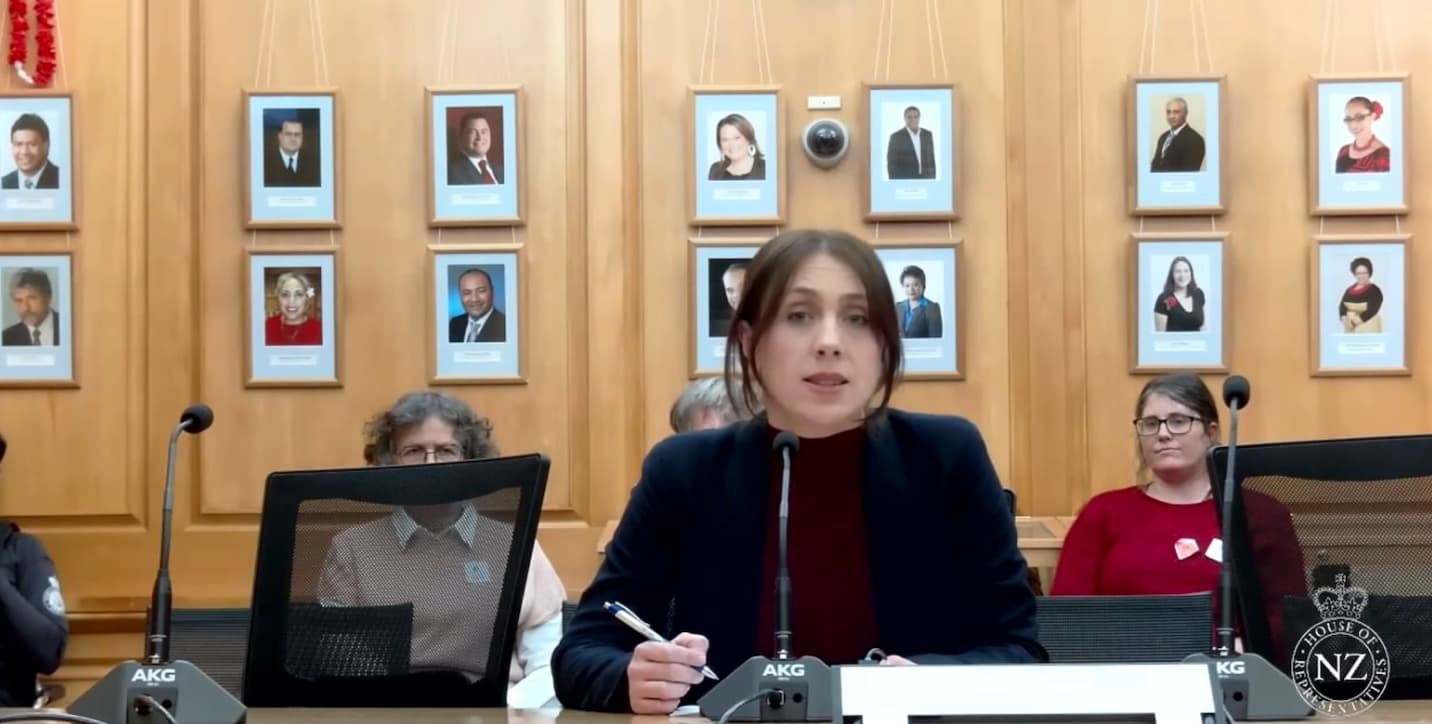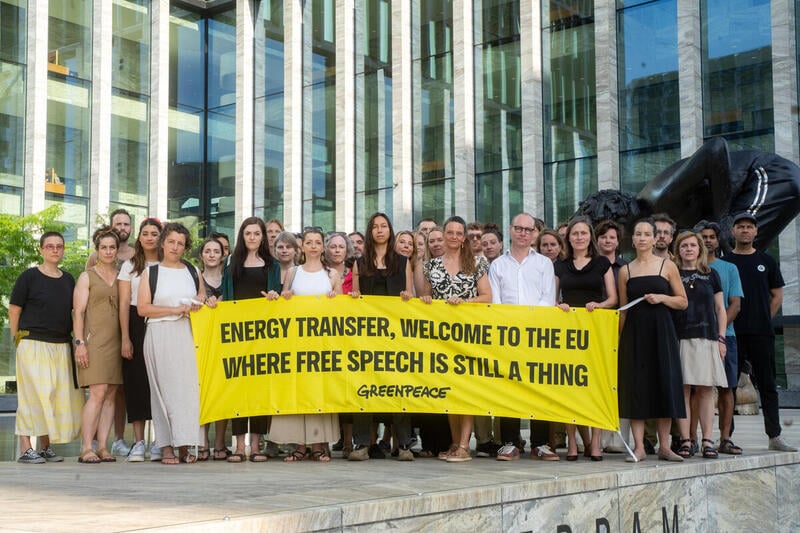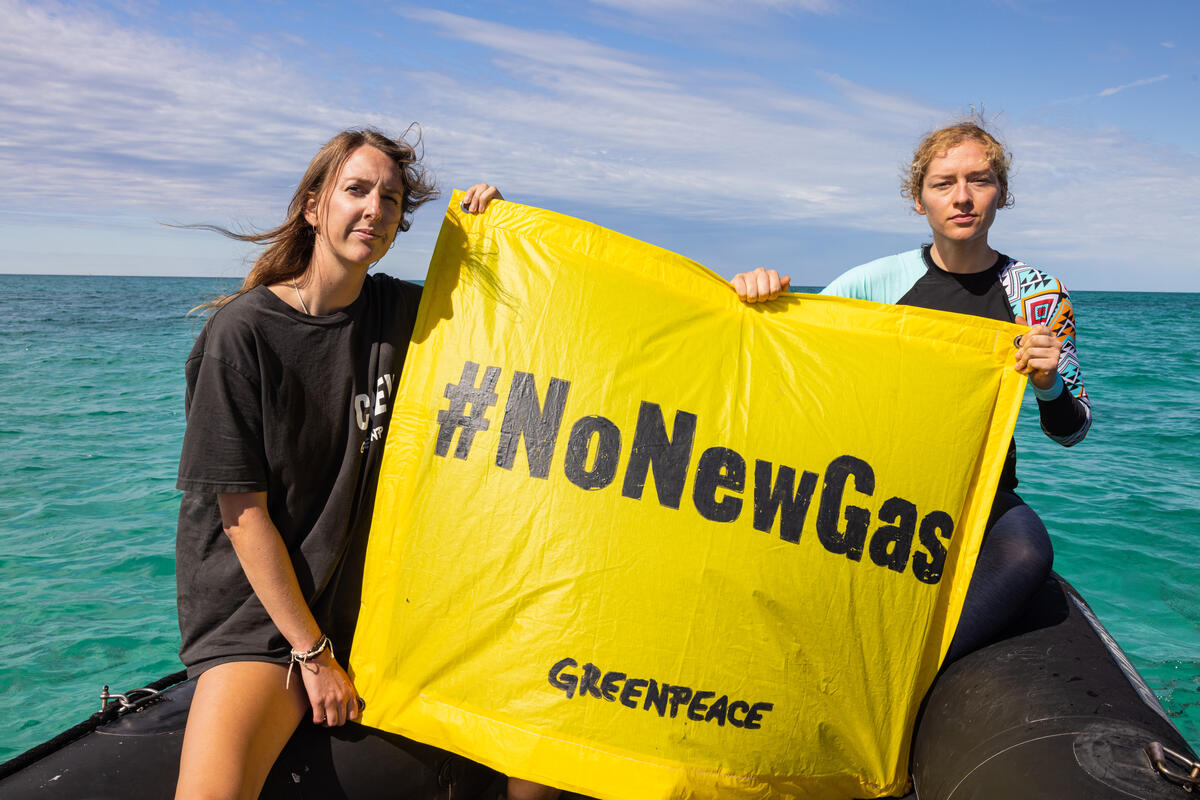Jacinda Ardern’s April 2018 ban on new oil exploration permits put New Zealand’s vast EEZ off limits to new oil and gas exploration except for a few areas where permits were released before the ban.
OMV possesses exactly half of these permits. The Austrian oil giant has just begun exploratory drilling in Taranaki, and has just been granted approval from the Environmental Protection Agency (EPA) to drill in the deep waters of the Great South Basin this summer.
Searching for more oil and gas is an obvious threat to the climate, but we also face an additional risk. OMV’s exploratory drilling in the deep and remote waters of the Great South Basin opens up the terrifying possibility of a large scale oil spill in New Zealand waters.
In 2010, BP’s disastrous Deepwater Horizon blowout in the Gulf of Mexico focussed the world’s attention on the devastating environmental and economic consequences of a deep sea oil drilling disaster.
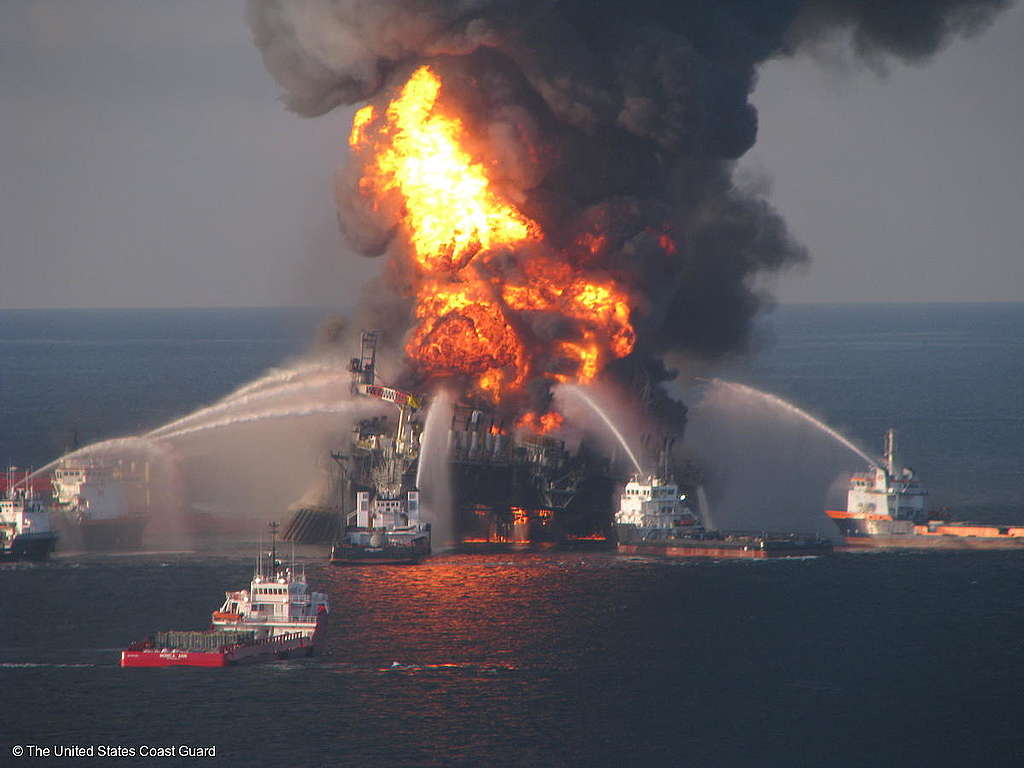
There are some scary parallels with what OMV plans to do. It’s deep, it’s exploratory, and it’s far from help should anything go wrong.
One of the reasons the Deepwater Horizon blowout was so catastrophic was that it was in deep water, which made it extremely difficult to cap.
The cost of drilling in deeper water is not linear with depth; it increases exponentially. So, too, the risk of a blowout also increases with depth. The challenges faced are significant and complex: from the rig to the deepest section of the well.
In New Zealand, the current deepest production well is only 125 meters below sea level. In the Great South Basin, OMV plans to drill at water depths of around 1300m.
On top of that, exploratory drilling is the riskiest phase of drilling.
Very little is certain about the type of hydrocarbons present or the pressure of a potential reservoir prior to the first well being drilled. They just don’t know what they’ll find.
The source of the Deepwater Horizon disaster was an exploratory well.
Then there’s the question of oil spill response preparedness.
OMV’s Tawahaki-1 drill site in the Great South Basin is 85 nautical miles offshore from Dunedin – twice the distance the stricken Deepwater Horizon was from shore. And it’s in a region with very little exploration infrastructure.
The EPA decision seems fatally optimistic when they say “…we are satisfied that Maritime New Zealand and other agencies have the plans, structures, processes, access to equipment, and financial resources to respond to an oil spill event should one occur.”
The Rena oil spill showed us how unprepared New Zealand is for such an emergency, and the oil spilled there was only a fraction of what could be spilled by a deep sea drilling blowout.
The Deepwater Horizon response had around 4,100 kilometres of containment booms, and deployed 47,000 people and over 6,000 vessels including dozens of purpose built response ships of up to 70 meters in length.
Maritime New Zealand has just three 11-metre flat-bottomed inner harbour aluminium boats to service the whole country.
The EPA goes on to say:
“We accept that the overall environmental effects on the biological environment, existing interests, and cultural values from a significant oil spill event could be extensive”
No shit. The deepwater horizon blowout disgorged 650,000 tonnes of oil.
So how bad would a spill be? Bad, really bad. But it’s hard to say for sure.
OMV has provided some oil spill modelling for its Great South Basin drillsite, but an independent analysis commissioned by Greenpeace found it to be badly lacking.
The OMV’s spill modeling assumes any blowout would take a maximum of 21 days to cap, but the Deepwater Horizon blowout lasted 87 days.
Without adequate oil spill modelling, we can’t get an accurate idea of what the impact of an oil spill by OMV this summer could be. But in 2013, Greenpeace commissioned modelling of an oil spill at Anadarko’s ‘Caravel Prospect’ drill site off the Otago Coast near where OMV plans to drill this summer.
It painted a terrifying picture of what could happen if a blowout were to occur there…
From day 1, thousands of barrels of oil could flow into the ocean every day.
To stop the spill, a relief well would need to be drilled. Rigs capable of doing that in deep water are highly unlikely to be available in New Zealand to do the drilling, so an available rig will have to be located and contracted from overseas.
On day 4 the spill response is overwhelmed.
Maritime New Zealand is responsible for responding to the spill. After only four days, it is likely that their dispersant supplies will have run out and that their three small boats, if they can even make it to the area at all, will have been overwhelmed, any additional help will need to come from offshore.
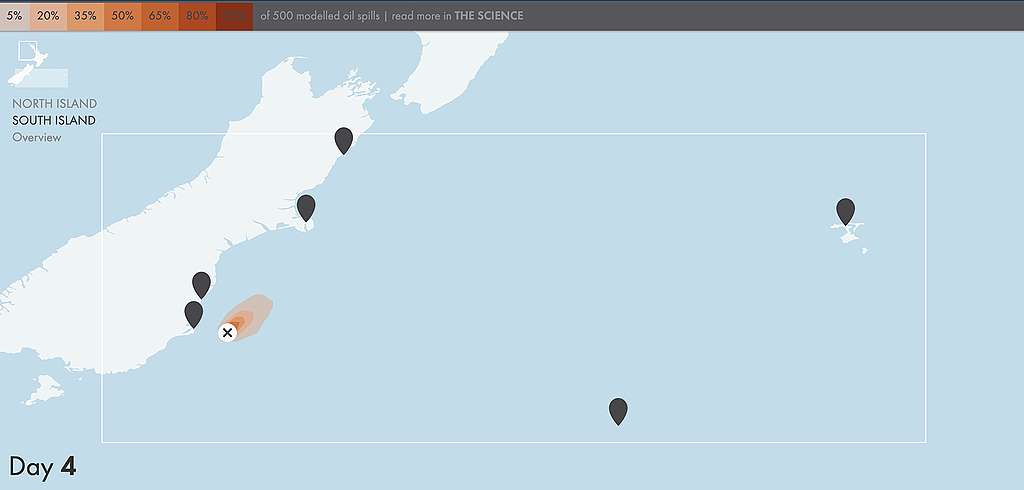
On day 23 the relief rig finally arrives at drill site.
Fortunately, in this scenario an uncontracted relief rig capable of drilling in deep water was available on Australia’s North West Shelf. After the long journey to New Zealand it has finally reached the drill site.
The complicated task of drilling into the damaged well to perform the necessary kill operations and stop the blowout can now begin.
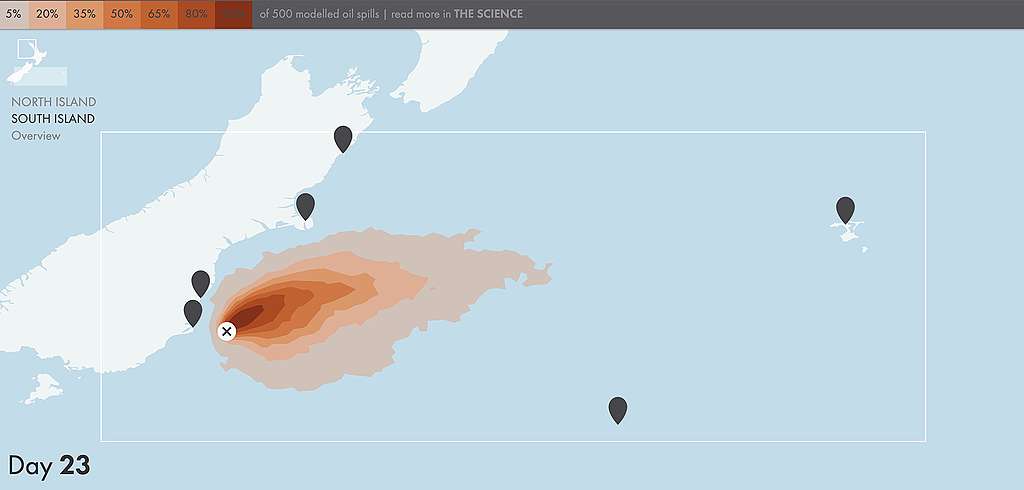
On day 35, Oamaru penguins are on the frontline of the oil spill.
The probability modelling map shows the likelihood that a particular area will be impacted by more than 1g/m2 of oil. This threshold is the amount of oil that would require a beach clean up.
In the worst case scenarios (a probability of 5%), Oamaru’s local penguins may not only have to contend with a dangerous oil slick out at sea, but oil may also wash up on the beaches where they come ashore each evening.
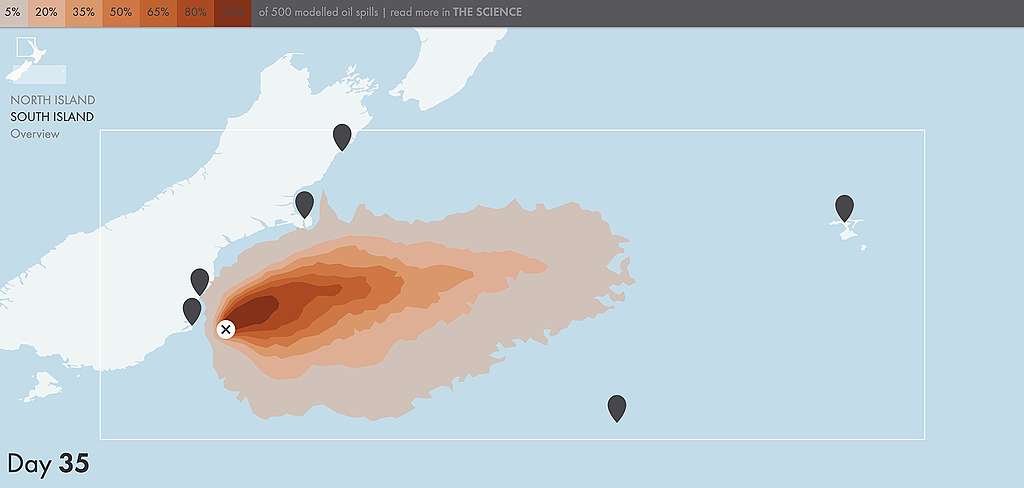
On day 70, Kaikoura’s whales are under threat.
Tourists flock to the coastal town of Kaikoura to see sperm whales. However, after 10 weeks, a vast area of their preferred habitat off the Eastern coast of the South Island could be impacted by the oil spill. In the worst case scenarios (probability 5%), even the beaches of Kaikoura will need to have oil cleaned from them.
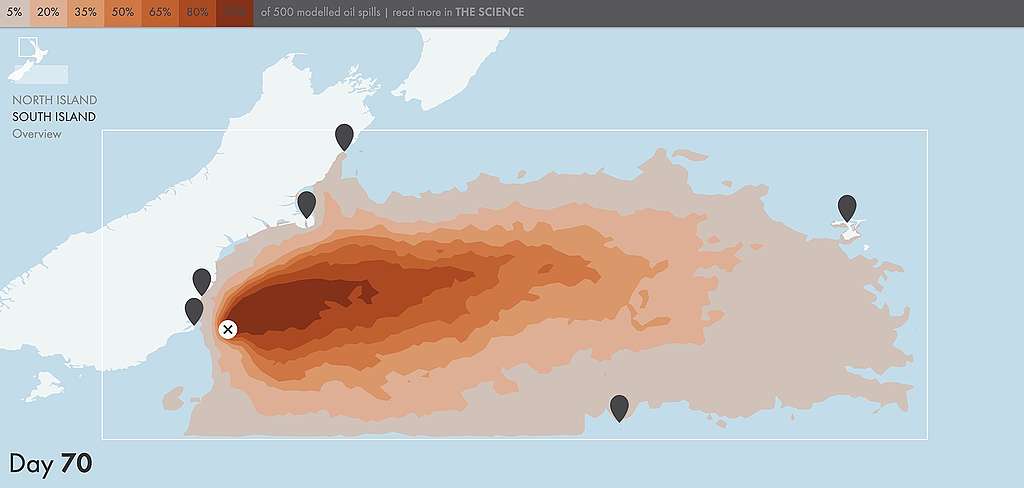
On day 76 the relief well is completed.
Relief well operations took relatively little time in this scenario and the damaged well is finally intercepted and plugged. Oil is no longer spilling into the ocean, but a large quantity is very likely to remain on the sea surface.
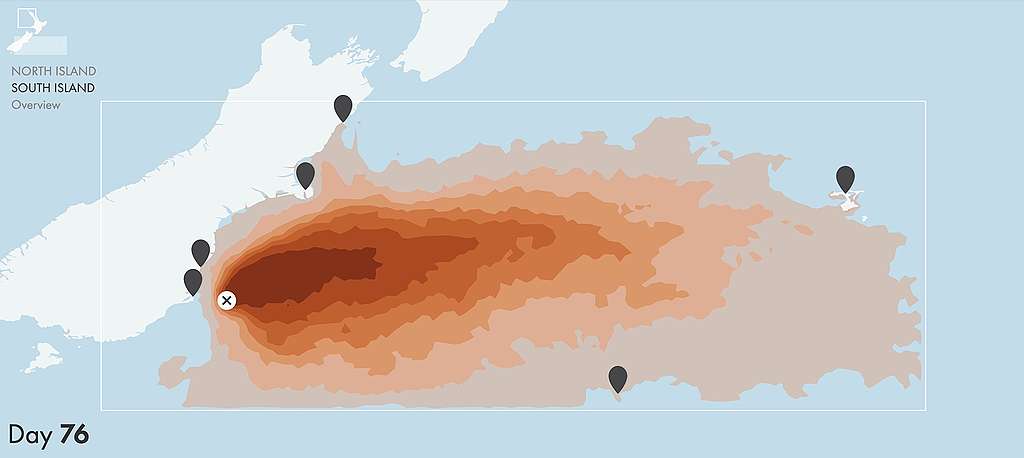
On day 90, there is a wide impact plume.
Despite hundreds of kilometers separating the Chatham Islands from the site of the blowout, a spill could now impact these islands. After three months, the worst hit parts of the Chatham’s have a 35% probability of oil affecting the shoreline.
Combined with the impacts on the prime oceanic foraging grounds of the Chatham Rise, a spill could have disastrous consequences for the unique seabird and marine life of these islands.
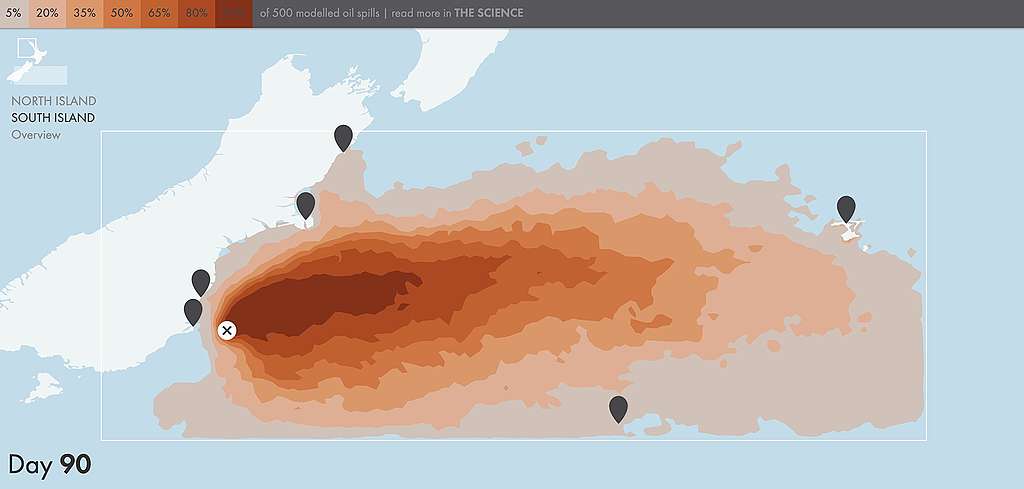
On day 120 there are ongoing impacts.
Although the blowout was stopped over a month ago, oil will very likely continue to drift across the ocean and wash up on the coast. Sadly, this is not the end of the disaster, as the effects of the spill will likely endure for years to come.
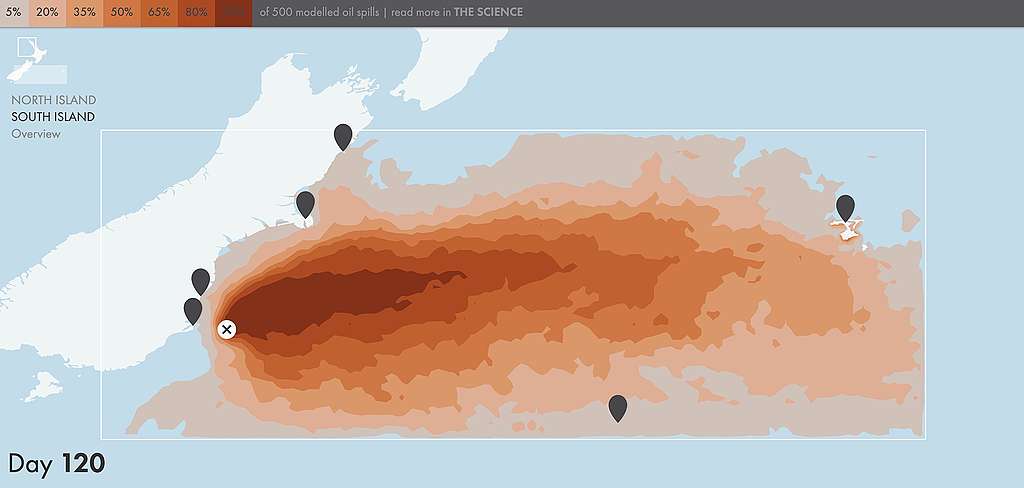
So, can we apply that modelling to OMV’s Great South Basin drillsite this summer?
Yes and no.
Back in 20123, the exact drilling location for Anadarko’s Caravel site was estimated from statements made by Anadarko to its investors because the precise drilling locations were only publicly released after our study was completed. Because of that, we tested whether varying the precise release site would change the probabilistic maps. It resulted in minimal alteration to the overall impacts.
However, the OMV drill site is further from the coast and a further south. But because they have only modelled 21 days of oil spill, it’s impossible to say how far the oil would travel, and whether oil would wash up on shore or not.
Either way though, oil spills are toxic to marine life, and a big blowout could leak large amounts of oil into our oceans for months.
We also have another problem.
OMV is keeping its spill response plan out of the public domain.
What is OMV trying to hide?
Knowing how difficult it has been to adequately respond to major oil spills elsewhere in the world, perhaps OMV is hoping to keep prying eyes away from a plan that no doubt makes for very worrying reading and raises many questions.
Questions like these:
What dispersant does OMV plan to use? Is it for example the controversial Corexit used following the Deepwater Horizon oil spill?
If a chemical dispersant is part of the plan, how much do they plan to use? Chemical dispersants disperse the spill into finer droplets so that it mixes into the ocean. Nearly 2 million gallons of dispersants were used during the Deepwater Horizon response. This is equivalent to 9 megalitres, or nearly 4 olympic-sized swimming pools worth of dispersant alone. Corexit has been shown to greatly increase the toxicity of oil.
How many people does OMV and Maritime New Zealand have available to respond to an oil spill? The Deepwater Horizon response mobilised 47,000 people…
Do they have containment booms ready, and if so how many and do they expect them to work in the wild waters of the Great South basin? Within weeks of the Deepwater Horizon spill, BP deployed over 4,100 kms of containment booms. Despite this, serious questions were raised about the efficacy of the technology – the vast majority of oil spilled in the Gulf of Mexico was never recovered. Indeed, together with burning, booms and dispersants, estimates are that only removed 16% of spilled oil.
OMV’s Tawahaki-1 drill site in the Great South Basin is 85 nautical miles offshore from Dunedin. This is over twice as far as the Deepwater Horizon rig was from the Texas coast back in 2010.
What vessels does OMV – and Maritime New Zealand – have available to deal with a spill? In the Gulf of Mexico, BP’s Deepwater Horizon disaster required the use of nearly 900 oil skimmers and around 6,000 vessels in total. Maritime New Zealand maintains the capacity to respond to spills of up to 3,500 tonnes and has a total of three ‘Oil Response Vehicles’. Basically three inshore harbour capable tinnies. They are located in Northland, Auckland and Wellington.
How does OMV plan on dealing with harm to New Zealand’s wildlife in the event of a spill?
The 2010 Deepwater Horizon Disaster has been described as the worst environmental disaster in the history of the United States.
BP has said the Deepwater Horizon cost it US$62 billion. In New Zealand, a spill even a fraction of this scale has the potential to devastate our environment and economy.
New Zealand and our offshore islands are home to 25% of the world’s breeding seabird populations. An estimated 80% of New Zealand’s native biodiversity is found in the sea.
Aside from the risk to the climate, these are risks that are not worth taking.
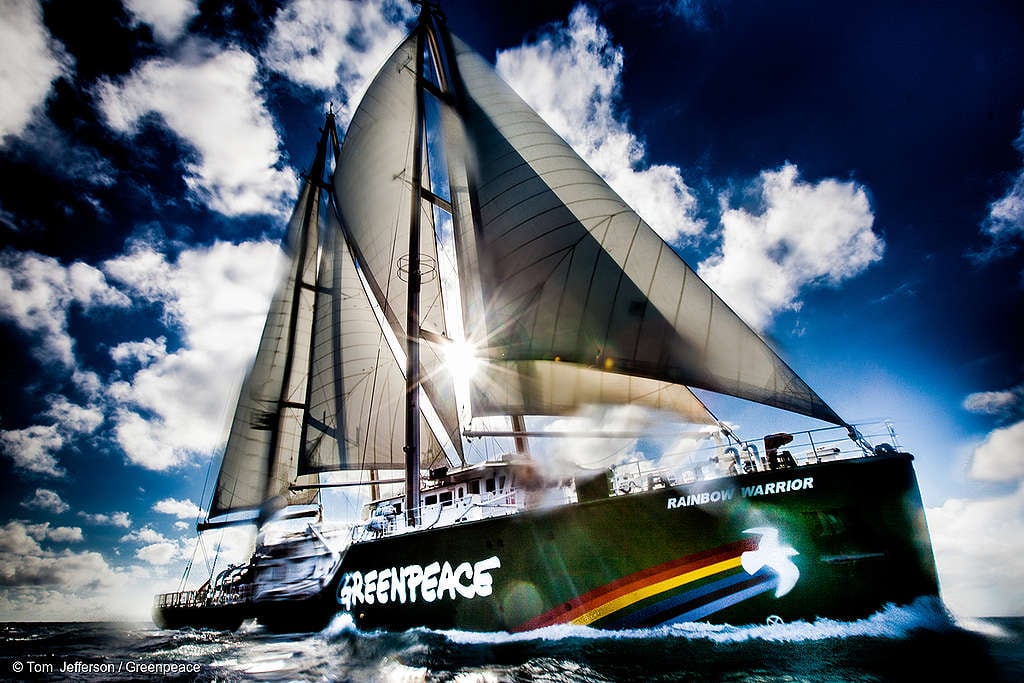
Donate to Greenpeace today. We take no money from corporations or governments. Our independence and ability to speak and act freely is our greatest strength. To maintain that freedome, we rely on the generosity of people like you to keep us in action.
Take Action
